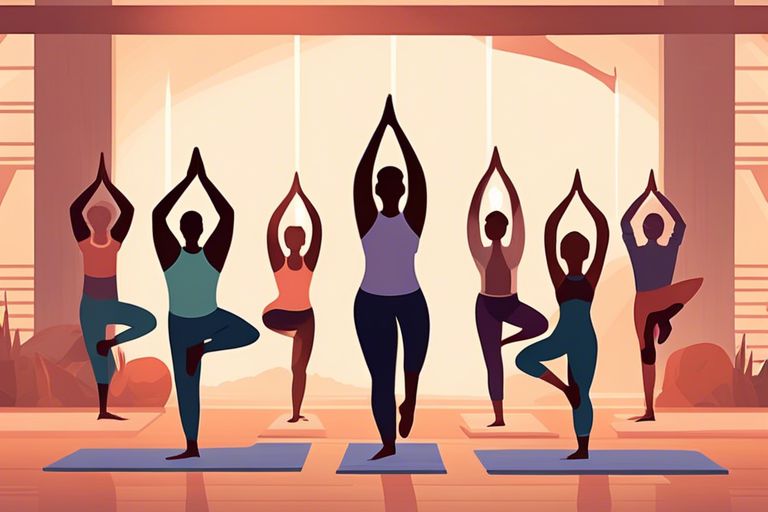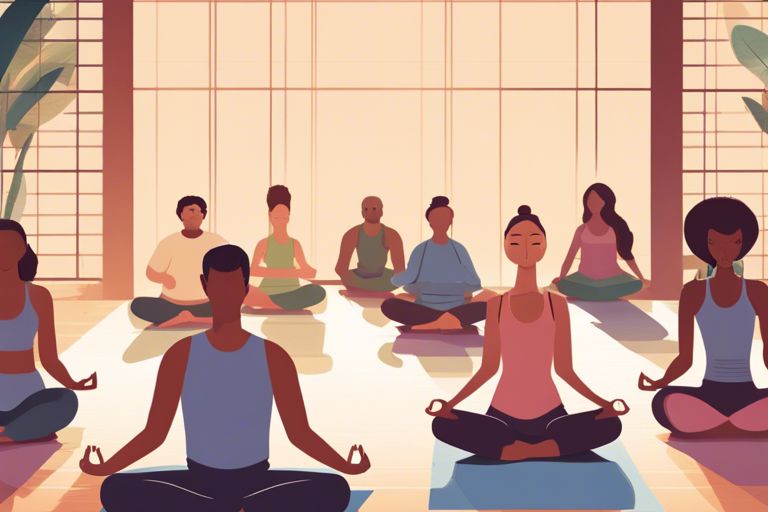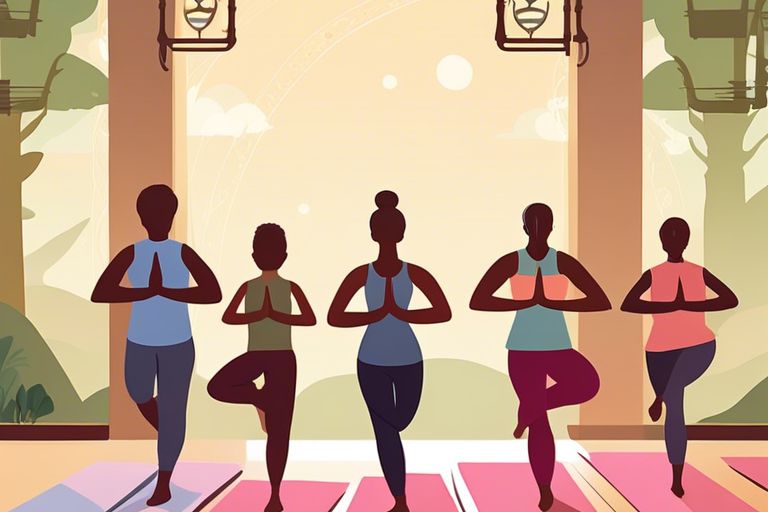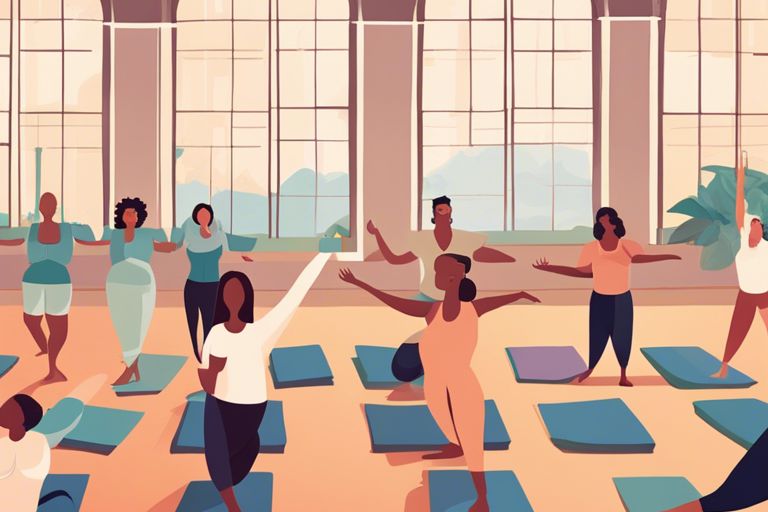This ultimate how-to guide will help you master yoga workout routines like a pro, ensuring your practice is safe, effective, and fulfilling. Learn the most important poses, sequences, and techniques to enhance your strength, flexibility, and mindfulness during your yoga sessions. Whether you are a beginner or experienced yogi, this comprehensive guide provides everything you need to take your practice to a whole new level.

Key Takeaways:
- Variety: Incorporating a variety of yoga poses and sequences into your workout routine can help target different muscle groups and improve flexibility.
- Consistency: Consistent practice is key to seeing progress in your yoga practice. Whether it’s a daily routine or a few times a week, regularity is important.
- Listen to Your Body: Paying attention to your body’s needs and limitations during your yoga practice is crucial to prevent injuries and ensure a safe workout.
1. Choose a quiet, spacious area for your yoga practice.
2. Begin with a gentle warm-up to prepare your body.
3. Follow a routine that includes different yoga poses.
4. Focus on your breathing and hold poses for 5-10 breaths.
5. Add in balance poses and stretches to improve flexibility.
6. End with a relaxation pose and deep breathing exercises.
Understanding Yoga Workout Routines
The practice of yoga involves a combination of poses, breathing exercises, and meditation techniques that promote physical and mental well-being. Understanding the different types of yoga workout routines can help you find the one that best suits your needs and preferences.
Types of Yoga Workout Routines
- Hatha Yoga: Focuses on physical postures and breathing techniques to achieve balance and relaxation.
- Vinyasa Yoga: Involves flowing movements synchronized with the breath to create a dynamic and energetic practice.
- Ashtanga Yoga: A fast-paced style that follows a specific sequence of poses to build strength, flexibility, and focus.
- Bikram Yoga: Practiced in a heated room, this routine includes a set series of 26 poses to detoxify the body and increase flexibility.
- Yin Yoga: A slow-paced style that involves holding postures for extended periods to target the deep connective tissues in the body.
Perceiving the differences between these yoga workout routines can help you choose the one that aligns with your goals and preferences.
On the other hand, factors to consider when choosing a routine include your fitness level, flexibility, and any specific health concerns. You should also consider the amount of time you can commit to your practice and whether you prefer a more gentle or dynamic style of yoga. Recognizing these factors can help you select a routine that will be safe and effective for you in the long run.
Factors to Consider When Choosing a Routine
- Fitness Level: Consider your current strength and flexibility when selecting a routine to ensure it is challenging but not too strenuous.
- Health Concerns: If you have any injuries or medical conditions, choose a routine that is appropriate and safe for your body.
Recognizing the importance of these factors will help you tailor your yoga workout to meet your specific needs and avoid any potential risks or injuries.
Preparing for Your Yoga Workout Routine
Essential Equipment and Props
For your yoga workout routine, you will need some vital equipment and props to enhance your practice. Items such as a yoga mat, yoga blocks, a yoga strap, and a yoga bolster can help you deepen your stretches, improve your alignment, and provide extra support when needed. Investing in these props is crucial to ensure a safe and effective yoga practice.
Creating a Conducive Environment
Now, let’s focus on creating a conducive environment for your yoga workout routine. Find a quiet and clutter-free space in your home where you can practice without distractions. You can enhance the ambiance by lighting candles, burning incense, or playing soothing music to set the right mood for your practice. Creating a calming environment can help you relax and focus on your yoga session.
Equipment such as a diffuser with vital oils can also add to the peaceful atmosphere and promote relaxation during your practice. Choose scents like lavender or eucalyptus to create a spa-like experience at home.
Warming Up and Stretching
There’s no yoga routine without a proper warm-up and stretching session. Before entering into more advanced poses, it’s vital to prepare your body by gently warming up your muscles and joints. Incorporating dynamic movements like cat/cow stretches, sun salutations, and gentle twists can help increase blood flow and flexibility. Warming up properly can prevent injuries and ensure a more effective yoga practice.
Plus, including stretching exercises in your routine can help improve your overall flexibility and range of motion. Focus on stretching major muscle groups like hamstrings, hips, and shoulders to release tension and improve your posture.
Step-by-Step Yoga Workout Routines
Beginner-Friendly Routines
Even if you are new to yoga, there are beginner-friendly routines that can help you ease into your practice. These routines focus on gentle poses and movements that help you build strength and flexibility while also introducing you to the basic principles of yoga. You will learn how to connect your breath with each movement, improving your focus and relaxation.
| Your Beginner-Friendly Routine: | Start with a gentle warm-up, then move into foundational poses such as Child’s Pose, Downward Dog, and Warrior I. Focus on your breathing and listen to your body’s needs. |
Intermediate Routines for Strength and Flexibility
Yoga intermediate routines are designed to challenge you further and enhance both your strength and flexibility. These routines incorporate more advanced poses and transitions that require greater balance and muscle engagement. You will continue to deepen your practice and explore new ways to move your body.
| Yoga Intermediate Routine: | Combine dynamic sequences like Sun Salutations with balancing poses like Tree Pose and Extended Side Angle. Focus on maintaining a steady breath throughout the practice. |
Plus, you can incorporate props like yoga blocks or straps to deepen your stretches and improve alignment in challenging poses. Intermediate routines help you progress beyond the basics and enhance your overall physical and mental well-being.
Advanced Routines for Weight Loss and Toning
Advanced yoga routines are ideal for those looking to amp up their practice for weight loss and toning. These routines are more intense and challenging, incorporating a combination of strength-building poses, dynamic movements, and longer holds to increase calorie burn and sculpt your muscles.
- Routines for Weight Loss and Toning: Combine powerful flows like Chaturanga Dandasana with core-strengthening poses like Boat Pose. Incorporate inversions like Headstand for an added challenge.
The advanced routines push you to your limits, helping you break through physical and mental barriers to achieve your fitness goals. These routines require dedication and focus, but the results are rewarding as you build strength, endurance, and confidence in your practice.

Tips for a Successful Yoga Workout Routine
To ensure a successful yoga workout routine, here are some important tips for you:
- Set realistic goals: Establish achievable objectives for your practice to keep you motivated and focused.
- Stay consistent: Regular practice is key to reaping the benefits of yoga, so make sure to incorporate it into your routine regularly.
- Listen to your body: Pay attention to how you feel during practice and adjust poses as needed to prevent injury and promote progress.
Knowing the right techniques and approaches will help you optimize your yoga sessions. For more in-depth guidance, you can refer to Yoga for Athletes The Ultimate Guide | True North Sports.
Breathing Techniques and Meditation
One of the fundamental aspects of yoga practice is mastering breathing techniques and meditation. Deep breathing helps you stay present and calm during your practice, while meditation enhances focus and mental clarity. Incorporating these practices into your routine can elevate your yoga experience and promote overall well-being.
Alignment and Posture
Any successful yoga workout routine emphasizes proper alignment and posture. Aligning your body correctly in each pose not only maximizes the benefits but also reduces the risk of injury. Focusing on your posture helps improve balance, strength, and flexibility, making your practice more effective and rewarding.
With correct alignment and posture, you can optimize the impact of each pose and prevent strain on your muscles and joints. Remember to engage your core, relax your shoulders, and lengthen your spine to maintain proper alignment throughout your practice.
Modifying Routines for Injuries and Limitations
One important aspect of success in yoga practice is knowing how to modify routines for injuries and physical limitations. If you have specific health concerns or restrictions, it’s crucial to adapt poses accordingly to avoid exacerbating existing issues. Consult with a yoga instructor or physical therapist to learn modifications that suit your needs and ensure a safe practice.
Plus, modifying routines for injuries and limitations can help you continue your yoga journey while promoting healing and preventing setbacks. By making necessary adjustments, you can still experience the benefits of yoga and work towards your wellness goals in a safe and sustainable manner.

The Pros and Cons of Different Yoga Styles
Not all yoga styles are created equal. Each one has its unique benefits and drawbacks. It’s important to understand the pros and cons of each style so you can choose the one that best suits your individual needs and preferences.
Hatha Yoga: Benefits and Drawbacks
| Benefits | Drawbacks |
| Improves flexibility and strength | Can be slow-paced and less dynamic |
| Focuses on breathing and relaxation | May not provide as much of a cardio workout |
Any time you need a gentle introduction to the most basic yoga postures, Hatha yoga would be a great place to start. Your body will likely become more flexible and toned over time. However, if you’re looking for a more vigorous workout that gets your heart rate up, you may find Hatha yoga a bit too slow-paced for your liking.
Vinyasa Yoga: Advantages and Disadvantages
| Advantages | Disadvantages |
| Increases strength and flexibility | Can be challenging for beginners |
| Improves cardiovascular health | Fast-paced nature may lead to injuries if not practiced carefully |
Any time you want to flow through poses and work up a sweat, Vinyasa yoga is an excellent choice. It can help build strength, increase flexibility, and improve your cardiovascular health. Different from Hatha yoga, Vinyasa yoga is more dynamic and energetic, with a focus on synchronizing your breath with your movements. However, the fast-paced nature of Vinyasa can sometimes lead to injuries if you push yourself too hard.
Different yoga styles cater to different needs and preferences, so it’s vital to explore and find the one that resonates with you the most. Remember to listen to your body and choose a style that aligns with your fitness goals and level of experience.
Restorative Yoga: Pros and Cons
| Pros | Cons |
| Relieves stress and promotes relaxation | Not as physically challenging as other styles |
| Helps with recovery and rejuvenation | May not provide a significant workout for those seeking more intensity |
Restorative yoga focuses on relaxing and restoring the body through gentle poses and deep breathing. It is perfect for anyone looking to de-stress, unwind, and release tension from the body and mind. While it may not be as physically demanding as other styles, it offers a much-needed opportunity to find stillness and relaxation in today’s fast-paced world.
Common Mistakes to Avoid in Your Yoga Workout Routine
Overexertion and Injury Prevention
All too often, in your eagerness to progress in your yoga practice, you might be tempted to push yourself too hard. Overexertion can lead to injury and setbacks in your fitness journey. It’s crucial to listen to your body and know your limits. Remember that yoga is about balance and self-awareness, not about pushing yourself to the point of harm.
Improper Alignment and Form
Proper alignment and form are key to reaping the benefits of your yoga practice and avoiding injury. Clearly, improper alignment can strain your muscles and joints, leading to discomfort and potential harm. Take the time to focus on your form and seek guidance from a qualified instructor if needed.
For instance, if you consistently practice poses with incorrect alignment, you may not experience the full benefits of the pose and could potentially injure yourself over time. Paying attention to alignment and form will not only enhance the effectiveness of your practice but also help prevent injuries.
Lack of Focus and Mindfulness
Form a strong mind-body connection during your yoga practice by staying present and focused. When you allow your thoughts to wander, you risk losing the benefits of the practice and possibly compromising your safety. Remember that yoga is not just a physical workout but also a mental exercise that requires mindfulness and concentration.
To fully experience the holistic benefits of yoga, it’s imperative to remain present and focused throughout your practice. By cultivating mindfulness, you not only improve your physical alignment and performance but also foster a deeper connection between your mind, body, and spirit.
To wrap up
Hence, by now, you should feel confident in creating your own yoga workout routines. Remember to tailor your practice to your goals and listen to your body throughout your sessions. Combining yoga with strength training can also be a great way to enhance your fitness routine. If you’re looking to create a combined routine, you can check out this helpful guide on Creating a Combined Yoga and Strength Training Routine.
Q: What are some common yoga poses for beginners?
A: Some common yoga poses for beginners include Mountain Pose (Tadasana), Downward-Facing Dog (Adho Mukha Svanasana), Warrior I (Virabhadrasana I), and Child’s Pose (Balasana).
Q: How can I improve my flexibility through yoga?
A: To improve flexibility through yoga, focus on practicing poses that target specific muscle groups such as Forward Fold (Uttanasana) for hamstrings, Cobra Pose (Bhujangasana) for chest and shoulders, and Pigeon Pose (Eka Pada Rajakapotasana) for hips.
Q: What are the benefits of incorporating yoga into my workout routine?
A: Some benefits of incorporating yoga into your workout routine include improved flexibility, increased strength, stress relief, better posture, enhanced focus and concentration, and a sense of overall well-being.











